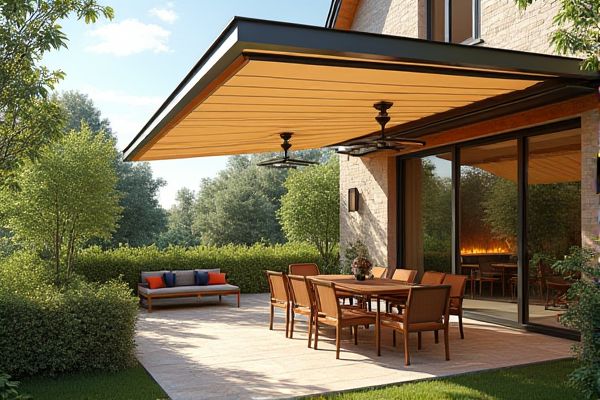
Balcony awnings provide flexible shade with retractable fabric designs, perfect for controlling sunlight and protecting from rain, while pergolas offer a sturdy, often decorative structure that supports climbing plants and create a more permanent outdoor space. Discover which option best suits Your outdoor living needs by reading the full comparison in the article.
Table of Comparison
| Feature | Balcony Awning | Pergola |
|---|---|---|
| Purpose | Provides shade and rain protection for balconies | Creates outdoor structure with partial shade |
| Material | Fabric with metal or aluminum frame | Wood, metal, or vinyl |
| Installation | Mounted to balcony wall or ceiling | Freestanding or attached to building |
| Shade Coverage | Full shade when extended | Partial shade with open roof slats |
| Weather Protection | Protects from sun and light rain | Limited rain protection, mainly sun filtering |
| Retractability | Usually retractable or foldable | Usually fixed structure |
| Customization | Limited to fabric colors and patterns | Customizable design, size, and materials |
| Cost | Lower initial cost | Higher initial cost |
| Maintenance | Requires fabric cleaning and frame check | Needs occasional wood treatment or metal upkeep |
| Longevity | 3-10 years depending on fabric and care | 10-20+ years with proper maintenance |
Introduction to Balcony Awnings and Pergolas
Balcony awnings are retractable or fixed fabric covers designed to provide shade and protection from sun and rain, enhancing outdoor comfort and energy efficiency. Pergolas consist of open-frame structures with cross beams and climbing plants or fabric for partial shade, creating an elegant, airy outdoor space that blends architecture with nature. Both solutions improve balcony usability but vary in installation, maintenance, and aesthetic impact.
Key Differences Between Awnings and Pergolas
Awnings offer retractable, lightweight shade solutions ideal for balconies, providing adjustable coverage and protection from sun and rain. Pergolas consist of sturdy, open-roof frames that support climbing plants or fabric covers, creating a semi-permanent shaded outdoor space with architectural appeal. Your choice depends on desired flexibility, installation complexity, and aesthetic preference, with awnings favoring versatility and pergolas emphasizing structure and design.
Design and Aesthetic Appeal
Balcony awnings offer sleek, retractable designs that provide versatile shade while maintaining a minimalist look, perfect for modern urban spaces. Pergolas create a more architectural and permanent structure, allowing for decorative climbing plants and customizable roofing options that enhance outdoor ambiance. Your choice depends on whether you prefer the streamlined functionality of an awning or the distinctive, elegant presence of a pergola.
Sun and Weather Protection Comparison
Balcony awnings offer superior sun protection with adjustable fabric that blocks harmful UV rays while allowing ventilation, making them ideal for varying weather conditions. Pergolas provide partial shade through slatted roofs and can be enhanced with retractable canopies or climbing plants, offering moderate weather protection but less versatility against rain or strong winds. Your choice depends on whether you prioritize flexible sun shielding and rain protection from an awning or the aesthetic and structural charm of a pergola.
Installation Process and Requirements
Balcony awnings typically feature simpler installation, requiring mounting brackets and fabric attachment directly to the balcony structure, making them suitable for compact spaces with limited weight support. Pergolas demand a more robust installation, involving sturdy posts anchored into the ground or balcony floor and overhead beams for structural integrity, often necessitating professional assistance and adherence to building codes. The choice between the two hinges on the balcony's load capacity, desired permanence, and local regulations affecting installation complexity.
Durability and Maintenance Needs
Balcony awnings typically offer durable, weather-resistant fabrics such as acrylic or vinyl that require minimal maintenance like occasional cleaning and retraction during severe weather to prolong lifespan. Pergolas, constructed from materials like wood, aluminum, or steel, demand more upkeep including periodic sealing, painting, or rust prevention depending on the material used. The choice between a balcony awning and a pergola hinges on balancing long-term durability with maintenance preferences specific to climate exposure and material properties.
Cost Analysis: Awning vs. Pergola
Balcony awnings typically cost between $200 and $1,000, offering an affordable and flexible shading solution compared to pergolas, which can range from $3,000 to $15,000 depending on materials and customization. Installation fees for awnings tend to be lower due to their simpler structure, while pergolas require professional labor for assembly and possible permits, increasing overall expenses. When budgeting your outdoor space upgrade, an awning provides cost-effectiveness and ease of installation, whereas pergolas represent a higher investment with long-term durability and aesthetic appeal.
Suitability for Various Balcony Types
Balcony awnings provide flexible shade solutions ideal for small to medium-sized balconies, accommodating various shapes and allowing easy retraction when not in use. Pergolas suit larger balconies or rooftop terraces, offering a more permanent structure that supports climbing plants and customized shading options. Both options enhance outdoor usability but differ in installation complexity and adaptability to balcony size and design.
Customization and Material Options
Balcony awnings offer extensive customization with fabric choices including acrylic, polyester, and vinyl, allowing for tailored UV protection and color options to suit various design preferences. Pergolas typically use durable materials such as wood, aluminum, or vinyl, providing structural versatility through adjustable slats or retractable canopies for enhanced shade control. Both solutions accommodate personalized dimensions, but pergolas excel in integrating architectural features, while awnings emphasize lightweight, weather-resistant fabrics for flexible installation.
Which Is Better: Balcony Awning or Pergola?
Balcony awnings provide flexible, retractable shade that is ideal for small spaces and varying weather conditions, offering protection from sun and rain while maximizing outdoor usability. Pergolas create a more permanent structure that enhances aesthetic appeal and can support climbing plants, but require more space and investment. Choosing between a balcony awning and a pergola depends on priorities like durability, customization, space constraints, and desired functionality for outdoor living areas.
 homyna.com
homyna.com